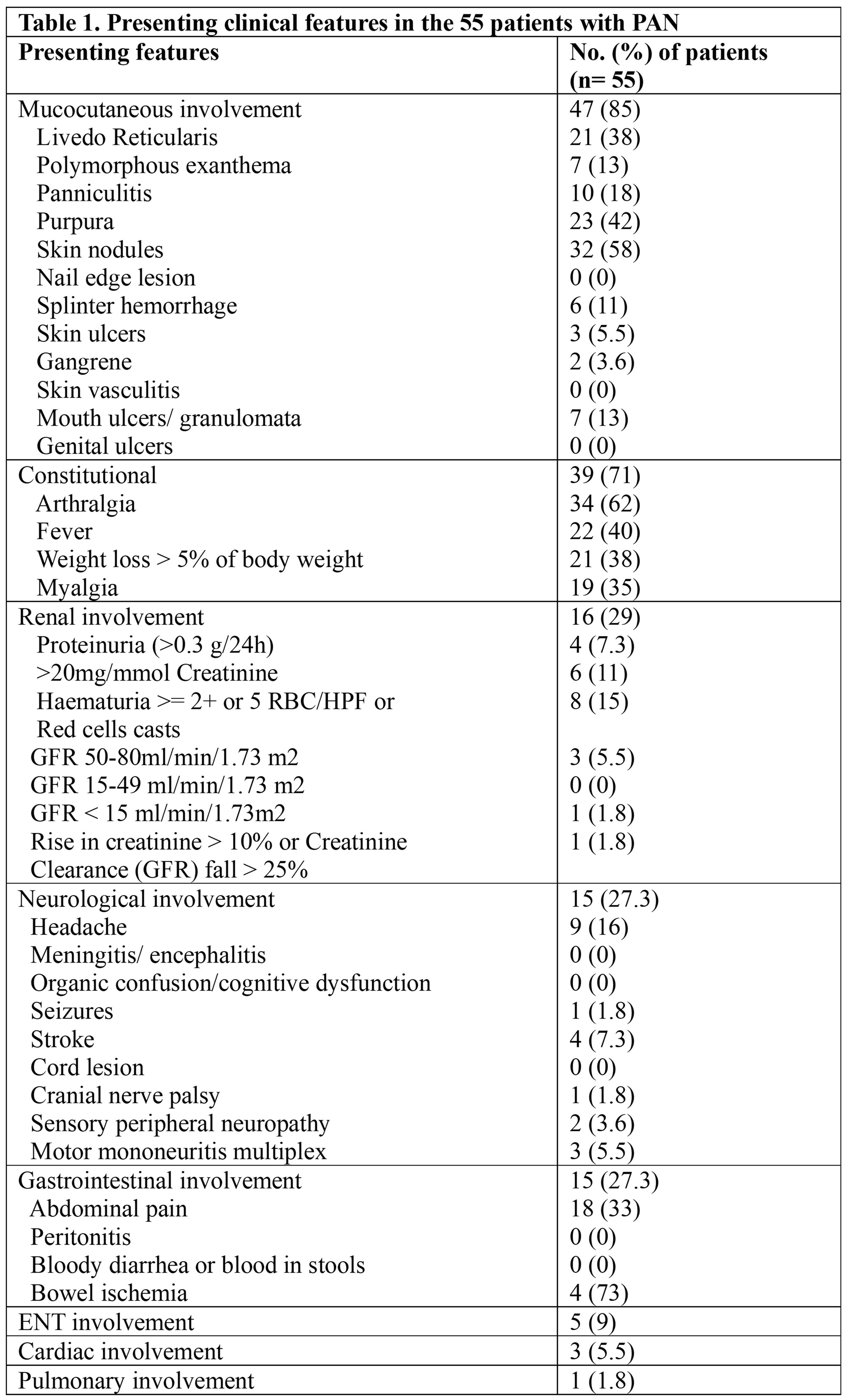Session Information
Date: Monday, November 13, 2023
Title: Abstracts: Pediatric Rheumatology – Clinical II: Connective Tissue Disease
Session Type: Abstract Session
Session Time: 2:00PM-3:30PM
Background/Purpose: Childhood polyarteritis nodosa (PAN) is a systemic vasculitis with necrotizing inflammation that typically affects small and medium-sized arteries. The clinical presentation is variable; it can either be cutaneous or systemic and can present with mild predominantly skin disease versus severe disease with multi-organ involvement. Since it is rare in children, the data are limited. The aims of this study are to characterize the clinical presentation, disease course and outcomes in childhood polyarthritis nodosa in an international cohort.
Methods: A multicenter ambispective study was conducted of children diagnosed with polyarteritis nodosa (PAN) using data collected in PedVas. PedVas is a multi-center, international study that is currently collecting clinical and biological data from children with chronic vasculitis. Eligible patients had an MD diagnosis of PAN and were < 18 years of age at time of diagnosis (TOD). Both systemic and cutaneous PAN subtypes were included. The primary outcome was the rate of inactive disease (Pediatric Vasculitis Activity Score [PVAS] of < =1) at 12 months. Secondary outcomes included rates of inactive disease at post induction (4–6 months after diagnosis), improvement rate in the PVAS at post induction (defined as a 50% reduction in PVAS), presence of damage at 12 months (measured by the Pediatric Vasculitis Damage Index [PVDI]) and relapse rates post induction.
Results: 55 children with PAN were included in the study; 19 were male, and the median age was 11 years (IQR 7-14.5). 25 of these patients were diagnosed as cutaneous PAN. 18 (33%) were Caucasian, 11 (20%) were East Asian, and 8 (14.5%) were South Asian. The most common presenting features were: mucocutaneous disease (85%), constitutional symptoms (71%), renal involvement (29%), gastrointestinal involvement (27.3%) and neurological involvement (27.3%). See Table 1. Corticosteroids were used in (80%) and cyclophosphamide in (26%). Other less frequently used agents included IVIG, methotrexate, azathioprine, other DMARDs, and biologic agents. An improvement in the PVAS score of more than 50% from TOD to post induction was seen in 79% of systemic PAN patients, and in 72% of cutaneous PAN. Rates of inactive disease at post induction and at 12 months in cutaneous PAN were 72%, and 74% respectively, and in systemic PAN were 63% and 67%, respectively. Relapses occurred in 2 (5%) of 39 patients after inactive disease had been achieved post-induction. 40 patients had completed PVDI scores at 12-months. The median PVDI score at 12 months was 0 in both cutaneous and systemic subgroups. 26 out of 40 patients (65%) had a PVDI score of 0, 14 (35%) had a PVDI score of 1 or more. There were no deaths.
Conclusion: This study describes the clinical course and outcomes of one of the largest cohorts of childhood PAN to date. The results show that the majority of patients have a reduction in disease activity by post-induction, and at least two-thirds of patients achieved inactive disease by 12-months. Disease relapse was rare in our cohort; however, one-third of patients have evidence of damage at 12-months. Further studies to evaluate predictors of treatment response and damage will help inform prognosis and guide treatment.
To cite this abstract in AMA style:
Alzaabi S, Bosman E, Cabral D, Morishita K, Investigators Network P. Clinical Presentation, Disease Course and 12-month Outcomes in Childhood Polyarteritis Nodosa: A PedVas Study [abstract]. Arthritis Rheumatol. 2023; 75 (suppl 9). https://acrabstracts.org/abstract/clinical-presentation-disease-course-and-12-month-outcomes-in-childhood-polyarteritis-nodosa-a-pedvas-study/. Accessed .« Back to ACR Convergence 2023
ACR Meeting Abstracts - https://acrabstracts.org/abstract/clinical-presentation-disease-course-and-12-month-outcomes-in-childhood-polyarteritis-nodosa-a-pedvas-study/

